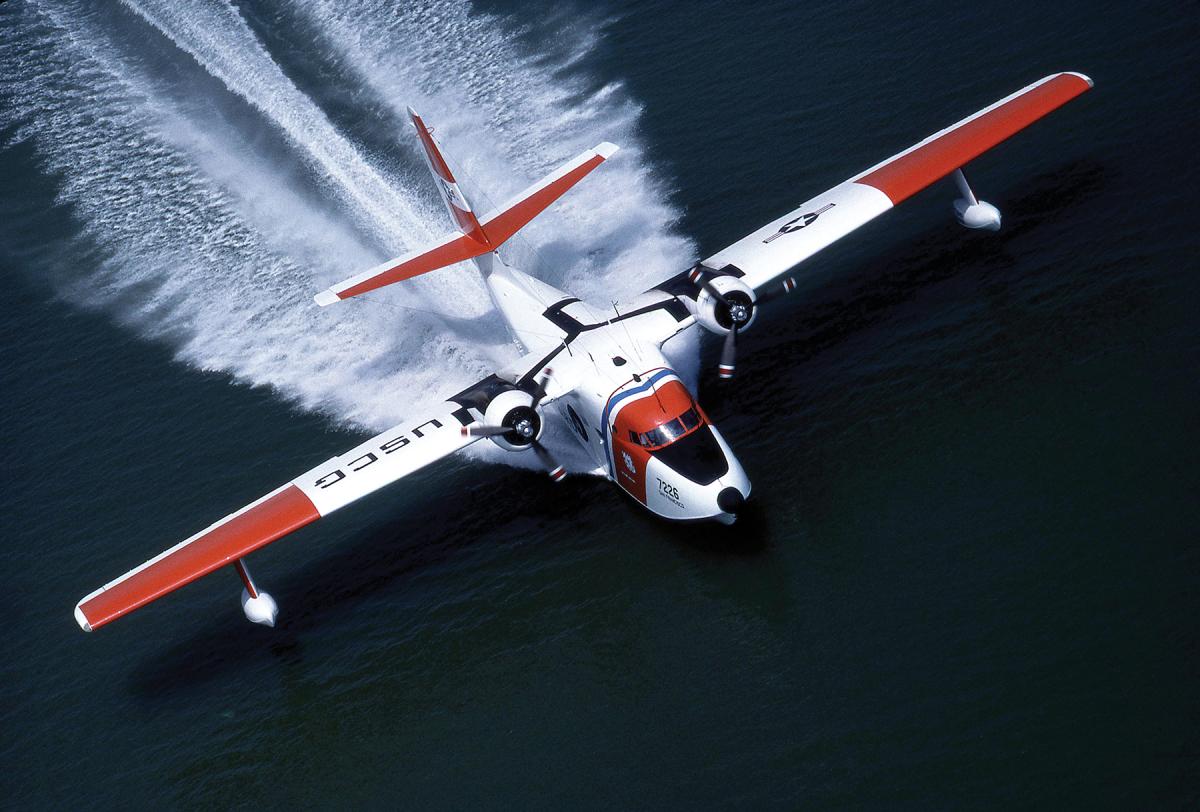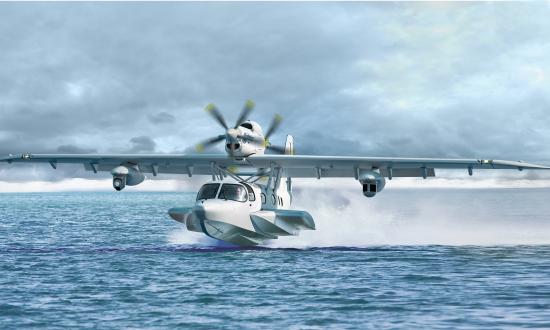The rapid growth of long-range conventional Chinese missile capabilities poses an existential threat to U.S. air bases inside what China calls the first and second island chains. The People’s Liberation Army Rocket Force boasts a range of conventional air-and ground-launched missiles that could pummel fixed infrastructure in Japan, South Korea, and even Guam.1 The vulnerability of U.S. bases in the region, particularly air bases, has created alarm inside and outside the military—from retired Admiral Harry Harris, former Commander of U.S. Pacific Command, to civilian analysts, who have compared Kadena Air Force Base in Okinawa to a “sitting duck.”2
Amphibious aircraft have a long, successful history as maritime patrol and transport platforms in the Pacific, but—critically—they can operate from but do not require airfields. Fully capable of landing and taking off from rivers, lakes, and the ocean, such amphibians could continue to operate forward from austere and dynamic base locations even after a crippling attack on fixed infrastructure. Their ability to persist forward and their proven value in maritime roles make amphibious aircraft a promising complement to other U.S. platforms in the western Pacific and a perfect fit for new and emerging operational concepts such as distributed maritime operations and expeditionary advanced base operations.
What are Amphibians?
Sometimes confused with flying boats, amphibious aircraft can take off from and land on both water and dry ground. (Flying boats cannot use runways.) Buoyancy is typically provided by a combination of underwing floats and the fuselage.
Amphibious aircraft are almost as old as conventional planes, with the first powered flight of an amphibious aircraft in 1911, a mere eight years after the Wright brothers’ first flight at Kitty Hawk, North Carolina. The innovative amphibian from Glenn Curtiss was promptly purchased by the Navy and christened the A-1 Triad.3 It went on to be the first catapult-launched aircraft and to break several aviation records. The U.S. and other navies used amphibious aircraft for gunnery spotting and reconnaissance long before the first purpose-built aircraft carrier was laid down.
Amphibious aviation was popular in the first half of the 20th century because such planes did not need developed airfields and were thus much less limited in where they could operate. They could drop passengers at remote islands or in any town on a river or lake. Avianca, the world’s second oldest airline, was an early adopter of float planes, using them to move passengers and cargo between rivers and lakes in Colombia.4 Amphibians are still used for passenger services in places with lots of water and limited infrastructure, such as the Caribbean and Alaska.
World War II was the heyday of amphibious aircraft. One of the most famous amphibians of that era was the twin-engine Consolidated PBY Catalina, of which more than 3,000 were built. The Catalina was versatile, serving in a multitude of roles from search and rescue to transport to maritime patrol. But the Catalina was certainly not the only example. The Navy had many amphibious aircraft: the Consolidated PB2Y Coronado, the Boeing 314 Clipper, and the Martin JRM Mars, among others. The Mars remained in service with the Navy until 1956, and one flew under civilian ownership as recently as 2016.
The British, Japanese, Soviet, and German militaries also had large and super large amphibious aircraft in service during the war, and development continued afterward. Largest of all was the Hughes Aircraft Company’s massive H-4 Spruce Goose, which held the world record for longest wingspan of any aircraft until 2019.
In the 1950s, the Navy ordered production of the Martin P6M SeaMaster, a twin-jet-engine amphibious aircraft capable of high-subsonic speeds, designed to deliver nuclear bombs from the sea as part of the Navy’s strategic deterrent. However, the program was canceled only a few months before reaching initial operational capability, when the Navy shifted its strategic nuclear weapon focus to the submarine-launched Polaris ballistic missile. Variants of the Grumman HU-16 Albatross, a twin-piston-engine amphibious aircraft, were flown by the Air Force and Navy through the 1970s and by the Coast Guard into the 1980s. The Albatross was exported to nearly two dozen countries and served as antisubmarine warfare aircraft with the Greek and Norwegian navies into the 1990s.
The Far East Movement
Seaplanes are making a big resurgence in the Indo-Pacific theater. Asian navies not only already operate amphibious aircraft for maritime patrol, transport, and search and rescue, but also are increasing their investments in amphibious aircraft, which are seen as cost-effective platforms that can be based or operated from remote and austere locations.
Russia, India, China, and Japan are all developing military seaplane forces. The Japan Self-Defense Force has operated a fleet of ShinMaywa amphibious US-2 aircraft for search and rescue since 2003. And Japan has been in negotiations for several years to export them to India (which, if successful, would be Japan’s first military sale since World War II). India reportedly wants to base amphibious aircraft in the remote Andaman and Nicobar Islands to patrol the western approaches to the Strait of Malacca to counter China’s growing naval reach.5
The People’s Liberation Army Navy (PLAN) has a long history of amphibious aircraft. It operated four-engine Harbin SH-5s as well as the Qing-6, an export variant of the Russian Beriev Be-6. The SH-5 operated in maritime surveillance and antisubmarine warfare—and even as a naval bomber. The PLAN is in the process of replacing its aged amphibian fleet and has ordered the AVIC AG600 Kunlong, which has a planned range of 2,800 miles. The Kunlong first flew in 2017 and is scheduled for delivery in 2021.6
On 3 September 2019, Russia announced a revival of its A-42 Albatross, a program that originally ended in 1993 after the fall of the Soviet Union. The Russian Defense Ministry announced the aircraft would be a maritime patrol platform also capable of laying mines.7 In February 2020, the Russian Navy began trials with another amphibious aircraft, the Beriev Be-200. Civilian variants of the Be-200 have been ordered for several countries, including a civil airline in the United States.8
Toward an Amphibious Future
Developing an entirely new platform would be expensive, but ample experience from U.S. history and current development by allies and partners could allow the Navy to start with an existing design as a basis. A critic of amphibious airplanes might note the increased wear and tear on the aircraft because of continual exposure to saltwater or reduced efficiency and payload when compared with land-based aircraft. But the ability to take off and land without a runway provides an intrinsic tactical advantage, and saltwater corrosion is an issue faced by all Navy aircraft operating at sea. The Navy is well versed in remediating the problem. In addition, amphibians would not be dependent on aerial refueling, alleviating critical demand on the overstressed U.S. tanker fleet.9
The incorporation of amphibious aircraft into Navy and Marine Corps aviation would increase the resilience and flexibility of the U.S. presence in the western Pacific and global littorals. Amphibious aircraft would also improve U.S. capability and deterrence by using cost-effective and long-established platforms.
1. Thomas Shugart and Javier Gonzalez, First Strike: China’s Missile Threat to U.S. Bases in Asia, Center for a New American Security, June 2017.
2. David Lague and Benjamin Kang Lim, “The China Challenge: Rocket Man,” Reuters, 25 April 2019; Seth Robson and Leon Cook, “Chinese Missile-Test Sites Appear to Mirror US Bases in Japan,” Stars and Stripes, 21 March 2017.
3. San Diego Air and Space Museum, “Curtiss A-1 Triad,” sandiegoairandspace.org/collection/item/curtiss-a-1-triad.
4. Avianca Cargo, “Company History,” www.aviancacargo.com/eng/com/history.aspx.
5. “Naval Air: Must Have Seaplanes,” Strategy Page, 27 March 2020, www.strategypage.com/htmw/htnavai/articles/20200327.aspx.
6. “AG600 Kunlong Large Amphibious Plane in Maiden China Flight,” BBC News, 24 December 2017.
7. “Russia to Resume A-42 Amphibious Aircraft Production,” Navy Recognition, 3 September 2019, www.navyrecognition.com/index.php/news/defence-news/2019/september/7455-russia-to-resume-a-42-amphibious-aircraft-production.html.
8. Vladimir Karnozov, “First Be-200 Intended for Russian Navy Takes Flight,” AIN Online, 19 February 2020, www.ainonline.com/aviation-news/defense/2020-02-19/first-be-200-intended-russian-navy-takes-flight.
9. Brian W. Everstine, “TRANSCOM: Keeping KC-135s, KC-10s Will Avoid Capacity ‘Train Wreck,’” Air Force Magazine, 7 October 2020.




